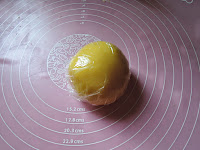Majority of leading St-Emilion estates are
located on the limestone plateau around the town or on the slopes, but
Canon-la-Gaffeliere is on the Pieds de Cotes, the limestone escarpment with
more sandy characters towards the foot of the slope. The name is
derived from gaffet, which translates as leper.
The land around the estate was the location
of a leper colony, which was still in existence in the 17th century,
during which a large area was purchased by the Comte de Malets-Roqueforts. The new
owners rented much of the land to share-croppers, with part of their harvest
paying to the landlord.
 The huge estate was divided as times went
by, with a portion owned by a gentleman called Boitard becoming the current
Chateau Canon-la-Gaffeliere, with the descendants of Comte de Malets-Roqueforts
held on to Chatean La Gaffeliere itself.
The huge estate was divided as times went
by, with a portion owned by a gentleman called Boitard becoming the current
Chateau Canon-la-Gaffeliere, with the descendants of Comte de Malets-Roqueforts
held on to Chatean La Gaffeliere itself.
The current owner is Comte Stephan von
Neipperg, whose father Joseph-Hubert, first came into the scene. Joseph-Hubert
was a descendant of Franconian nobility, the most recent generation of a long
line of successful winemakers in his homeland Wurttemberg, southwest of Germany.
He bought Canon-la-Gaffeliere in 1971, but
it was his son who was credited with the transformation of the estate since
taking over in 1985.
His recent vintages working with oenologist Stephane
Derenoncourt, allowing him to expand his portfolio, including Clos de
l’Oratoire, La Mondotte, Chateau d’Aiguilhe.
Located on the slopes of St-Emilion’s
limestone plateau, with limestone, clay and sandy soils, it is a single
block of vines with 19.5 hectares in size, planted with 55% Merlot, 40%
Cabernet Franc and 5% Cabernet Sauvignon, with density of 5500 vines per
hectare, averaging 45 years.
Stephan sees himself as a grower first,
winemaker second, with his vineyard now adopting biodynamic methods, and
certainly organic. Only low-nitrogen fertilizer is used, with all processes being
manual, yields are severely restricted.
 The fruit passes over a sorting table
before fermentation in temperature controlled wooden tanks, which replaced
stainless steel ones from 1997 onwards. There is pigeage of the cap and
micro-oxygenation, before the wine goes into barrels for up to 19 months, 100%
being renewed each year.
The fruit passes over a sorting table
before fermentation in temperature controlled wooden tanks, which replaced
stainless steel ones from 1997 onwards. There is pigeage of the cap and
micro-oxygenation, before the wine goes into barrels for up to 19 months, 100%
being renewed each year.
There is restricted use of sulphur, and in
barrel the wines are aged with lees. The wine is racked only once, with regular
batonnage. Very light fining and filtration is sometimes done, with the grand
vin being Chateau Canon-la-Gaffeliere of about 7500 cases per annum. A
second wine is made named Clos Mignon La Gaffeliere.
I have
recently tasted the 2006 vintage and below is my tasting note:
Appearance
Bright
and clear, it has deep ruby color, with garnet rims and legs.
Nose
Clean,
with medium intensity aromas of black fruit such as blackberry, dark cherries
and plum, herbal notes of tobacco leaf and eucalyptus, oak notes of cedar, kernel
notes of chocolate, pungent spice of licorice, hints of maturity savory notes.
The wine is developing.
Palate
Dry with
medium acidity, the wine has medium tannin of ripe and silky texture, with
medium (+) alcohol and full body. It has medium intensity flavors of black
fruit such as dark cherries, plum and blackberry, some herbal notes of tobacco
leaf, sweet spice of nutmeg, oak notes of caramel, kernel notes of chocolate.
The wine has a medium (+) finish.
Conclusion
Very
good quality St-Emilion with a reasonably intense nose showing good complexity,
the wine is a bit green when first opened, but after leaving to air for about
two hours it opened up beautifully. On the palate it is well-balanced, with
good structure and harmony, demonstrating fair concentration and complexity,
with a fairly long finish. It is ready to drink now though can benefit from
further ageing of another 3-5 years.
 Ingredients (for 4):
Ingredients (for 4):















































